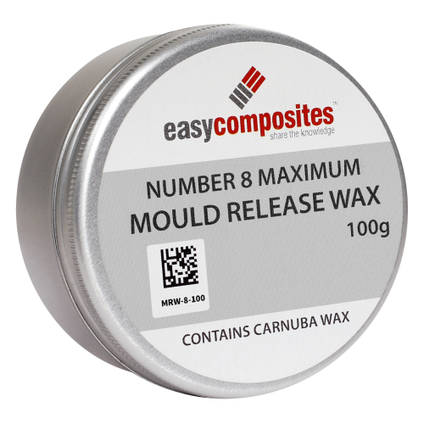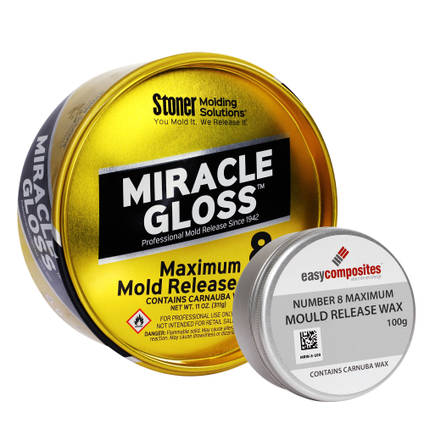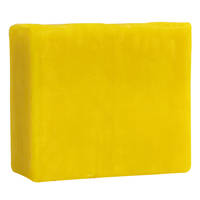Heb je hulp of advies nodig?+44 (0)1782 454499
Downloads (1)
| Veiligheidsinformatieblad (SDS) - NL |
Specificatie
Algemene Eigenschappen
| Brutogewicht | 0.12 | kg |
|---|
Verzendinformatie
Beperkingen
Dit product is niet geclassificeerd als gevaarlijke goederen voor transport en kan zonder beperkingen naar alle bestemmingen worden verzonden.
Verpakkingsgrootte
Er zijn geen beperkingen op de pakketgrootte of toeslagen voor dit product.
Verzendkosten
Om de bezorgkosten van dit artikel naar uw adres te achterhalen, voegt u het toe aan uw winkelwagen en gebruikt u vervolgens de directe verzendkosten calculator op de winkelwagenpagina.
Miracle Gloss Schimmelwerende Was
- MRW-8-100
- Geen Beoordelingen
Lossingswas is een traditioneel en nog steeds veel gebruikt lossingsmiddel bij het spuitgieten van composieten en Miracle Gloss (voorheen Meguiar's M-08) is een van de meest vertrouwde lossingswassen in de industrie.
Aanbrengen op het oppervlak van een mal met een doek, uitwrijven en herhalen om een glanzende, betrouwbare loslaatbarrière op te bouwen. Geschikt voor gebruik bij kamertemperatuur met polyester, vinylester en epoxyharsen.
Online te koop in een handig blik van 100 g of een gewoon blik van 310 g.
PRODUCTVERSIES
Verpakkingsgrootte
BESCHIKBAARHEID:Meer dan 10 beschikbaarvoor onmiddellijke verzending
We zijn niet te verslaan op prijs!
Als u denkt dat u elders een gelijkwaardig product goedkoper kunt kopen, neem dan contact met ons op om uw wensen te bespreken.
Lossingswas is het meest traditionele en nog steeds meest gebruikte lossingsmiddel in composieten.
Easy Composites' Number 8 Mould Release Wax is gekozen vanwege de uitstekende lossingseigenschappen, eenvoudige toepassing en uitzonderlijke spiegelglans.
Met dit handige blikje van 100 g kun je honderden releases maken van kleine tot middelgrote mallen.
Typisch Gebruik
Number 8 Mould Release Wax kan op zichzelf worden gebruikt om een betrouwbaar oppervlak voor matrijzen te creëren bij het maken van composieten met polyester-, vinylester- en epoxyharssystemen, maar is niet geschikt voor toepassingen bij hoge temperaturen, zoals uitharding bij verhoogde temperatuur, pre-preg of wet-lay waarbij de exotherm in het onderdeel het matrijsoppervlak boven de 50°C kan brengen.
Verdere informatie
Toepassing
Zorg ervoor dat het oppervlak van de mal goed is afgedicht (poreuze oppervlakken van de mal, zoals hout of gips, moeten worden afgedicht voordat er een lossingsmiddel voor de mal wordt aangebracht), schoon is en vrij van verontreinigingen.
Gebruik een schone, pluisvrije doek om een kleine hoeveelheid was op de doek te verzamelen (zoals schoenpoets) en breng het vervolgens met kleine cirkelvormige bewegingen aan op het oppervlak van je mal. Zorg ervoor dat je het hele oppervlak van de mal bedekt en let vooral op krappe hoeken.
Laat de was drogen, waardoor het uiterlijk iets 'matter' wordt en de swirls duidelijker zichtbaar worden op het oppervlak van de mal. Dit duurt ongeveer 15 minuten.
Gebruik een andere, schone, pluisvrije doek om voorzichtig over het oppervlak van de mal te strijken. Dit zal het draaipatroon van de was zachtjes glad maken. Houd de druk altijd heel licht, je wilt de was polijsten, niet verwijderen van het oppervlak van de mal. Zodra het oppervlak van de mal volledig vrij van wervelingen en glanzend is, moet je het aanbrengen van de wax nog ongeveer 3 keer herhalen, elke keer volgens dezelfde procedure als hierboven.
Lossingswas is het meest traditionele en nog steeds meest gebruikte lossingsmiddel in composieten.
Easy Composites' Number 8 Mould Release Wax is gekozen vanwege de uitstekende lossingseigenschappen, eenvoudige toepassing en uitzonderlijke spiegelglans.
Met dit handige blikje van 100 g kun je honderden releases maken van kleine tot middelgrote mallen.
Typisch Gebruik
Number 8 Mould Release Wax kan op zichzelf worden gebruikt om een betrouwbaar oppervlak voor matrijzen te creëren bij het maken van composieten met polyester-, vinylester- en epoxyharssystemen, maar is niet geschikt voor toepassingen bij hoge temperaturen, zoals uitharding bij verhoogde temperatuur, pre-preg of wet-lay waarbij de exotherm in het onderdeel het matrijsoppervlak boven de 50°C kan brengen.
Verdere informatie
Toepassing
Zorg ervoor dat het oppervlak van de mal goed is afgedicht (poreuze oppervlakken van de mal, zoals hout of gips, moeten worden afgedicht voordat er een lossingsmiddel voor de mal wordt aangebracht), schoon is en vrij van verontreinigingen.
Gebruik een schone, pluisvrije doek om een kleine hoeveelheid was op de doek te verzamelen (zoals schoenpoets) en breng het vervolgens met kleine cirkelvormige bewegingen aan op het oppervlak van je mal. Zorg ervoor dat je het hele oppervlak van de mal bedekt en let vooral op krappe hoeken.
Laat de was drogen, waardoor het uiterlijk iets 'matter' wordt en de swirls duidelijker zichtbaar worden op het oppervlak van de mal. Dit duurt ongeveer 15 minuten.
Gebruik een andere, schone, pluisvrije doek om voorzichtig over het oppervlak van de mal te strijken. Dit zal het draaipatroon van de was zachtjes glad maken. Houd de druk altijd heel licht, je wilt de was polijsten, niet verwijderen van het oppervlak van de mal. Zodra het oppervlak van de mal volledig vrij van wervelingen en glanzend is, moet je het aanbrengen van de wax nog ongeveer 3 keer herhalen, elke keer volgens dezelfde procedure als hierboven.
Downloads (1)
| Veiligheidsinformatieblad (SDS) - NL |
Specificatie
Algemene Eigenschappen
| Brutogewicht | 0.12 | kg |
|---|
Als je twijfelt is het altijd het beste om het zekere voor het onzekere te nemen en een extra laag aan te brengen!
De was heeft een maximale gebruikstemperatuur van 50°C, waardoor hij ongeschikt is voor toepassingen bij hoge temperaturen, zoals het uitharden van pre-Pregs.
Ik denk dat dit echt afhangt van hoe ruw het oppervlak van het aluminium is. Als we het hebben over veel lichte krassen over het hele oppervlak, dan is het zeer waarschijnlijk dat de gietwas, zoals Miracle Gloss, voldoende is om de krassen op het oppervlak van het onderdeel op te vullen en ervoor te zorgen dat de gietvorm zonder problemen loslaat. Hoe meer lagen was je aanbrengt, hoe waarschijnlijker het is dat dit het geval is.
Echter, als de krassen echt grof zijn, wat resulteert in een deel van het aluminium dat bijna uit het oppervlak steekt, dan zou dit meer zijn dat de was kan opvullen en zal dit er waarschijnlijk voor zorgen dat de mal mechanisch vastgrijpt en zich vastzet op dit oppervlak. Als dit het geval is, dan zal geen enkel lossingsmiddel betrouwbaar werken en in plaats daarvan moet u het oppervlak van het onderdeel verbeteren (met schuurpapier en staalwol) totdat het glad genoeg is en vrij van alles waar de mal zich aan vast kan houden. Als u het oppervlak met schuurpapier korrel 800 zou behandelen, zou er geen probleem zijn.
Hoe dan ook, gietwas is een goede keuze als je wat microtextuur in het oppervlak van een origineel onderdeel of patroon wilt aanbrengen. PVA is een andere goede optie, vooral als je het kunt spuiten zodat je meer dan één laag kunt opbouwen (meer dan één laag door het vegen van PVA is niet mogelijk).
Ja, mensen doen dit soms. Als je het gaat proberen dan is de volgorde was dan PVA, maar wat je waarschijnlijk zult vinden is dat de PVA zo erg van de was weg 'vist' dat het bijna onmogelijk is om een soort laag PVA op een gewaxt oppervlak te krijgen. Normaal gesproken eindig je met een paar vlekken PVA in sommige hoeken en dan strepen/parels in lijnen waar de wax het heeft afgestoten. Als dit niet gebeurt, is dat meestal een goede indicatie dat je de wax niet goed hebt aangebracht!
Als je geschikte materialen gebruikt voor je patronen en/of mallen, dan zou het nooit nodig moeten zijn om zowel wax als PVA te gebruiken, slechts één (meestal wax) op de juiste manier aangebracht is voldoende.
De was is niet geschikt als losmiddel op siliconen. Een eenvoudig, goed lossingsmiddel voor silicone op silicone is vaseline dat in een dunne laag wordt opgebracht.
Ja, als het oppervlak van je mal geschikt is (niet poreus) kun je de Mould Release Wax gebruiken om te voorkomen dat hars aan het oppervlak van je mal blijft plakken.
STEL UW EIGEN VRAAG
Waardering van klanten voor Miracle Gloss Mould Release Wax
DIEN UW EIGEN PRODUCTBEOORDELING IN
We publiceren alle beoordelingen van geverifieerde aankopen. Dien uw eigen beoordeling in en help andere klanten bij hun keuze.DIEN UW EIGEN PRODUCTBEOORDELING IN
We publiceren alle beoordelingen van geverifieerde aankopen. Dien uw eigen beoordeling in en help andere klanten bij hun keuze.Verzendinformatie
Beperkingen
Dit product is niet geclassificeerd als gevaarlijke goederen voor transport en kan zonder beperkingen naar alle bestemmingen worden verzonden.
Verpakkingsgrootte
Er zijn geen beperkingen op de pakketgrootte of toeslagen voor dit product.
Verzendkosten
Om de bezorgkosten van dit artikel naar uw adres te achterhalen, voegt u het toe aan uw winkelwagen en gebruikt u vervolgens de directe verzendkosten calculator op de winkelwagenpagina.
KLANTEN KOCHTEN OOK
KLANTEN KOCHTEN OOK
100% BEVEILIGD
BETALINGSMETHODEN
Easy Composites EU B.V., geregistreerd in Nederland 73601195. Alle inhoud auteursrechtelijk beschermd (C) Easy Composites Ltd, 2025. Alle rechten voorbehouden.


